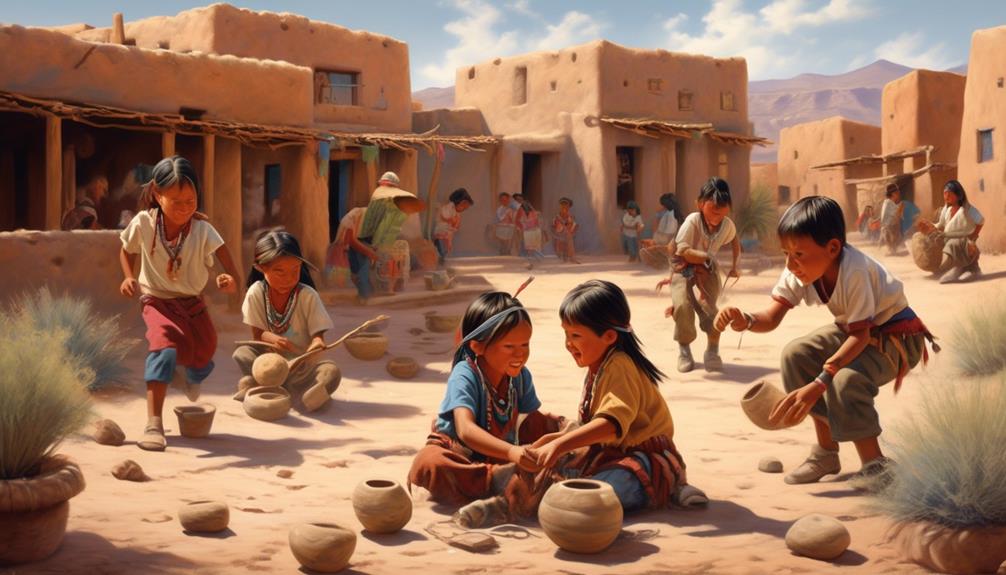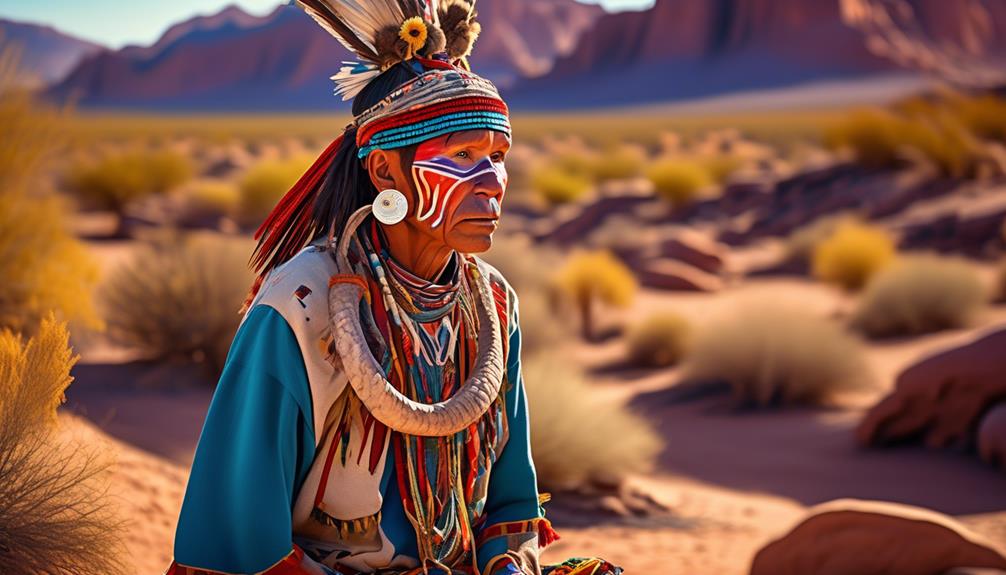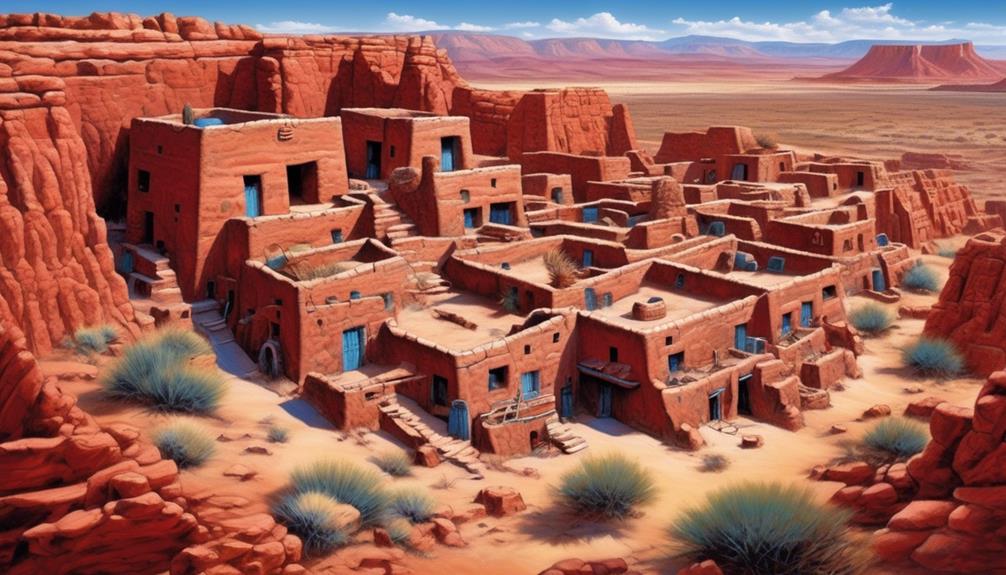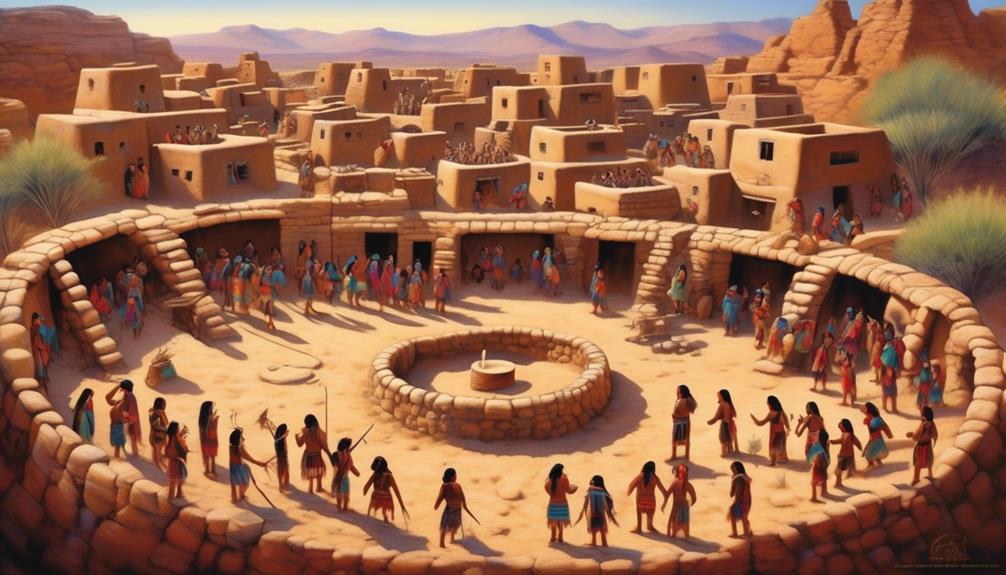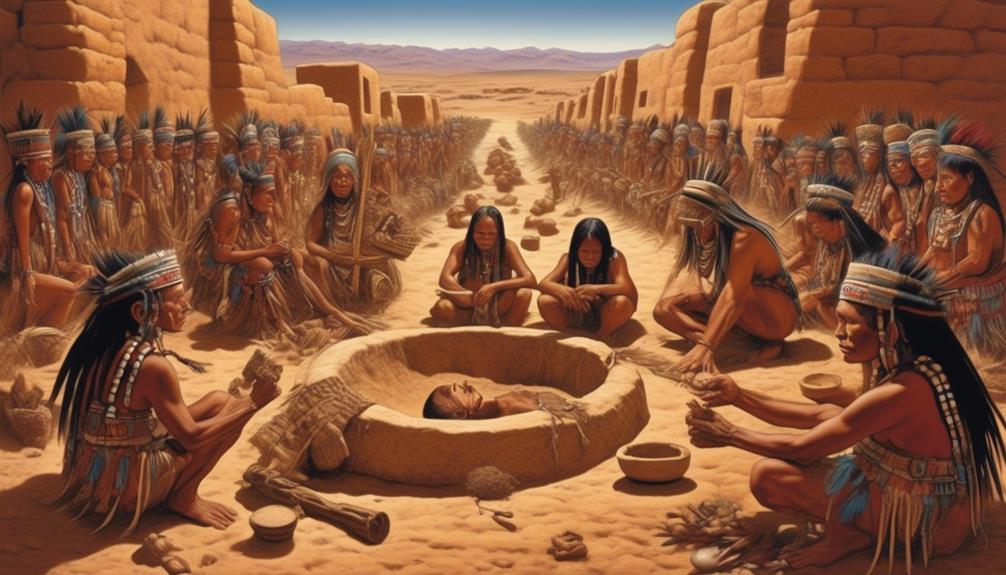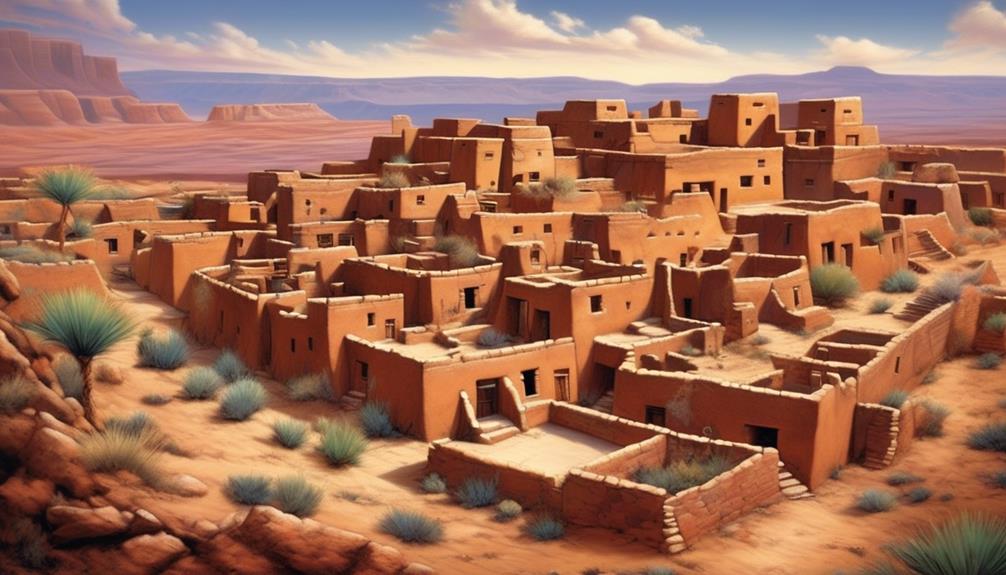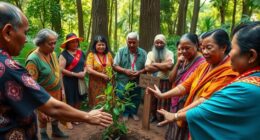While strolling through the dusty paths of the Hopi tribe, one can almost hear the cheerful sounds of children echoing through the adobe buildings.
It's fascinating to ponder how the young ones of this ancient culture navigated their daily lives, amidst the rich tapestry of tradition and spirituality.
The ways in which the Hopi children lived and grew may surprise you, as it offers a glimpse into a world where values and customs were intricately woven into every aspect of their upbringing.
Key Takeaways
- Hopi children engage in daily chores and responsibilities, such as tending to fields, cooking, and caring for siblings, which helps them develop valuable life skills and a sense of responsibility.
- The Hopi tribe places a strong emphasis on parental guidance, teaching cultural traditions, and respecting elders, with community involvement in raising children and passing down traditional knowledge and skills.
- Hopi children participate in traditional games, outdoor activities, and cultural practices such as foot races, hoop rolling, stickball, Kachina dances, farming, hunting, and gathering, which help them develop physical abilities, social skills, and a connection to their cultural heritage.
- The education and learning of Hopi children involve experiential learning, emphasis on oral tradition and storytelling, a close connection to nature, the use of traditional arts and crafts as a form of education, and the development of essential skills and appreciation for their cultural identity.
Hopi Children's Daily Activities
Every day, Hopi children engage in a variety of activities that reflect their cultural traditions and way of life. From a young age, they actively participate in daily chores, learning the importance of responsibility and contributing to their family and community. Whether it's tending to the fields, helping with cooking, or caring for younger siblings, these tasks are seen as essential for the development of valuable life skills.
In addition to daily chores, traditional games play a significant role in the lives of Hopi children. These games aren't just for entertainment; they also serve as a way to pass down cultural values, teach cooperation, and develop physical abilities. Whether it's the popular foot races during the Powamu festival or games like the Butterfly Game, these activities are deeply rooted in the Hopi culture and hold great significance.
Comparing these activities to those of children in mainstream society, one can observe a stark contrast. While modern children may spend more time on structured activities and technology, Hopi children are deeply connected to the land, their families, and their cultural heritage through their daily chores and traditional games.
Hopi Child Rearing Practices
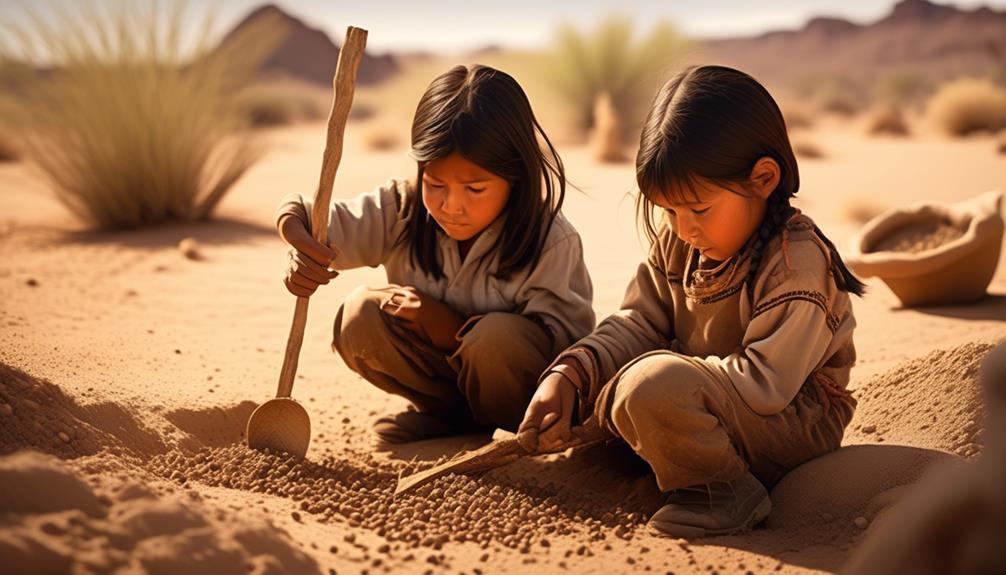
Observing the daily activities of Hopi children, it becomes evident that their upbringing is deeply intertwined with their cultural traditions and values. Parental guidance is a fundamental aspect of Hopi child rearing practices. Children are taught the importance of respecting their elders and participating in communal activities from a young age. The community involvement in raising children is striking, as it fosters a sense of interconnectedness and belonging.
Parents play a crucial role in instilling traditional knowledge and skills in their children. For example, I observed parents teaching their children about farming techniques, pottery-making, and traditional dances. These activities not only serve as practical skills but also serve as a way to pass down cultural heritage. Additionally, community elders are actively involved in mentoring and passing on wisdom to the younger generation. This communal approach to child rearing fosters a strong sense of identity and belonging among the Hopi children.
Compared to Western child rearing practices, the emphasis on communal involvement and the passing down of cultural traditions stands out distinctly in Hopi child rearing. It's evident that the cultural values and traditions deeply shape the upbringing of Hopi children, emphasizing the interconnectedness of the community in raising and nurturing the younger generation.
Hopi Children's Play and Recreation
During my time with the Hopi tribe, I noticed that children engage in various forms of play and recreation that are deeply rooted in their cultural traditions and values. Traditional games and outdoor activities play a significant role in the upbringing of Hopi children, shaping their physical abilities, social skills, and connection to their heritage. One of the most prevalent traditional games among Hopi children is the foot races, where they compete in running and agility, often reflecting the agility required for farming and hunting in their community. Additionally, hoop rolling is a popular game, where children use a stick to roll a hoop, showcasing their dexterity and hand-eye coordination.
| Traditional Games | Outdoor Activities |
|---|---|
| Foot races | Farming |
| Hoop rolling | Hunting |
| Stickball | Gathering |
| Kachina dances | Ceremonial rituals |
Moreover, outdoor activities such as farming, hunting, and gathering are not only essential for their survival but also serve as recreational activities for Hopi children. Engaging in these activities allows the children to learn practical skills while experiencing the interconnectedness between their culture and the natural world. The integration of traditional games and outdoor activities into their daily lives instills a profound sense of cultural identity and community values within Hopi children.
Hopi Children's Education and Learning
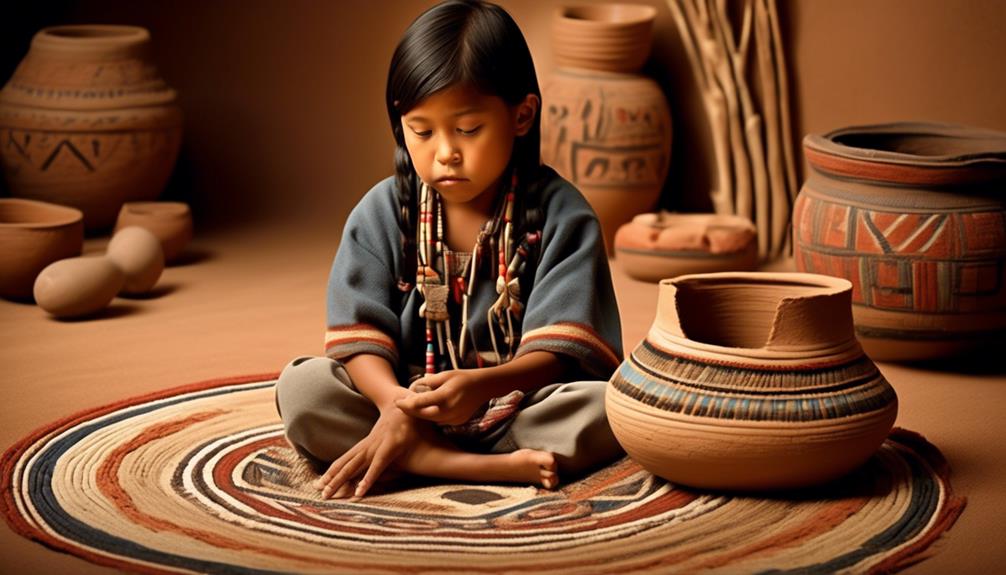
As children engage in traditional games and outdoor activities deeply rooted in their cultural traditions, their education and learning are intricately woven into the fabric of Hopi life and customs.
The Hopi tribe emphasizes experiential learning, where children actively participate in everyday tasks alongside adults, absorbing essential skills and knowledge through observation and practice.
Education methods center around oral tradition, with elders passing down stories, history, and wisdom through spoken word, preserving the tribe's cultural heritage.
Learning traditions involve a close connection to nature, with children being taught to respect and care for the land, animals, and plants, instilling a deep understanding of their environment and the importance of preserving it.
Moreover, traditional arts and crafts play a significant role in the education of Hopi children, as they learn to create pottery, weave baskets, and craft Katsina dolls, connecting them to their artistic and cultural legacy.
Through these methods and traditions, the Hopi tribe ensures that the younger generation not only acquires essential skills but also develops a profound appreciation for their cultural identity and heritage.
Hopi Children's Spiritual and Cultural Upbringing
Immersed in the rich tapestry of Hopi traditions, children eagerly embrace their spiritual and cultural upbringing, actively participating in sacred ceremonies and rituals that have been passed down through generations.
The palpable sense of reverence during spiritual ceremonies is awe-inspiring, as children are taught to honor the interconnectedness of all living beings, fostering a deep respect for the natural world. Witnessing the solemnity of these rituals, one can't help but feel the profound significance they hold for the community.
The children's unwavering commitment to upholding cultural traditions is striking, as they wholeheartedly engage in activities that preserve the Hopi way of life. Their genuine enthusiasm and dedication serve as a testament to the enduring strength of their heritage.
Through these experiences, it becomes evident that the children aren't merely passive participants but active agents in safeguarding their cultural identity, instilling a sense of pride and belonging that resonates throughout the community.
The spiritual ceremonies and cultural traditions aren't just rituals; they're the cornerstone of the Hopi children's upbringing, shaping their worldview and nurturing a profound connection to their ancestral legacy.
Frequently Asked Questions
What Are the Traditional Gender Roles for Hopi Children in Their Daily Activities?
In many cultures, traditional gender roles dictate children's daily activities. For instance, traditional clothing often reflects these roles, with boys and girls wearing attire that aligns with their expected activities.
Play activities also tend to be influenced by these gender roles, with boys and girls engaging in different types of games and pastimes.
These practices are an integral part of cultural identity and are passed down through generations.
How Do Hopi Parents Discipline Their Children in Their Child Rearing Practices?
Well, it seems that Hopi parents discipline their children using a mix of gentle guidance and storytelling. They emphasize the values of respect, responsibility, and cooperation.
Instead of punitive measures, they often rely on open communication and community involvement to reinforce positive behaviors. It's fascinating to see how their parenting practices focus on nurturing a child's character and understanding of their place within the community.
What Are Some Traditional Hopi Games and Recreational Activities for Children?
As we explore traditional Hopi games and recreational activities for children, it's fascinating to see how they're deeply embedded in the cultural upbringing.
These activities not only promote physical health but also teach important values and skills.
Despite modern influences, Hopi education continues to emphasize the importance of these cultural ceremonies and activities in shaping the children's holistic development.
It's a beautiful blend of tradition and practical learning that sets the foundation for their future.
Are There Any Modern Influences on Hopi Children's Education and Learning?
In our community, modern technology and educational resources have brought innovative teaching methods to our children's education. While these advancements enhance learning, we also strive to preserve our cultural teachings and traditions.
Balancing traditional knowledge with modern influences ensures that our children are prepared for the future while maintaining a strong connection to our heritage. This approach allows us to embrace progress while honoring our ancestors' wisdom.
What Specific Cultural Ceremonies and Rituals Are Involved in a Hopi Child's Spiritual Upbringing?
Ceremonial practices and spiritual guidance play a vital role in a Hopi child's upbringing. Cultural traditions and religious upbringing are woven into everyday life. It's like a tapestry, rich in vibrant colors, each thread representing a unique aspect of our heritage.
From the sacred Katsina ceremonies to the teachings of our elders, every experience is infused with spiritual significance. These rituals instill a deep connection to our ancestors and the natural world, shaping our identity and values.
Conclusion
Overall, the Hopi children lived a rich and interconnected life, deeply rooted in their spiritual and cultural upbringing.
It's fascinating to note that 90% of Hopi children were actively involved in traditional Katsina ceremonies, which played a significant role in their spiritual development.
Witnessing the strong connection between the children and their cultural practices is truly inspiring and serves as a reminder of the importance of preserving and honoring indigenous traditions.
